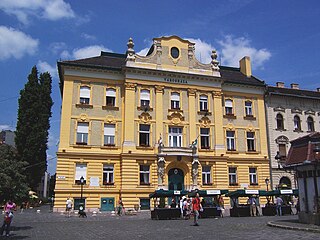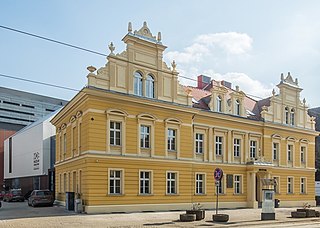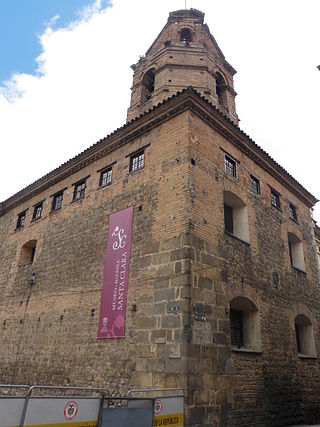
The Women's Museum Merano is located in a former convent of the Poor Clares in the centre of Meran (Italy). It is administrated by an association and is also the registration office of the International Association of Women's Museums (IAWM).

The Women's Museum Merano is located in a former convent of the Poor Clares in the centre of Meran (Italy). It is administrated by an association and is also the registration office of the International Association of Women's Museums (IAWM).
In its permanent exhibition the museum shows cultural and everyday history from a female point of view. The exhibits from the museum's collection include fashion, accessories, every day objects, books and documents. The museum represents female ideals, role models and images in 19th and 20th century, and thereby investigates the present situation of women in society.
In special exhibitions and various events there is an enlargement of the repertoire of female-specific and gender sensitive topics.
The museum was founded by Evelyn Ortner in 1988 and is administrated by an association since 1993. In 2011 the museum was transferred to the former convent of the Poor Clares.
In 2008 the first international congress of women's museums took place in Merano. Since then the Women's Museum Merano is coordination site of the International Association of Women's Museums (IAWM) and is connecting over 30 women's museums and initiatives worldwide.
Elke Krasny, Women's Museum Merano (ed.): Women's:Museum. Frauen:Museum. Curatorial Politics in Feminism, Education, History and Art. Löckerverlag, 2013.

A nun is a woman who vows to dedicate her life to God, typically living under vows of poverty, chastity, and obedience in the enclosure of a monastery or convent. The term is often used interchangeably with religious sisters who do take simple vows but live an active vocation of prayer and charitable work.

The Poor Clares, officially the Order of Saint Clare, originally referred to as the Order of Poor Ladies, and also known as the Clarisses or Clarissines, the Minoresses, the Franciscan Clarist Order, and the Second Order of Saint Francis, are members of a contemplative Order of nuns in the Catholic Church. The Poor Clares were the second Franciscan branch of the order to be established. Founded by Clare of Assisi and Francis of Assisi on Palm Sunday in the year 1212, they were organized after the Order of Friars Minor, and before the Third Order of Saint Francis for the laity. As of 2011, there were over 20,000 Poor Clare nuns in over 75 countries throughout the world. They follow several different observances and are organized into federations.

Óbuda was a town in Hungary that was merged with Buda and Pest on 17 November 1873; it now forms part of District III-Óbuda-Békásmegyer of Budapest. The name means Old Buda in Hungarian. The name in Serbo-Croatian for this city is Stari Budim, but the local Croat minority calls it Obuda. In Czech and the Slovak languages, it is called Starý Budín.

Limerick lace is a specific class of lace originating in Limerick, Ireland, which was later produced throughout the country. It evolved from the invention of a machine which made net in 1808. Until John Heathcoat invented a net-making machine in Devon in 1815, handmade net was a very expensive fabric. This meant cheap net became available to Irish lacemakers, particularly after 1823 when Heathcoat's patent expired.

Franciscan spirituality in Protestantism refers to spirituality in Protestantism inspired by the Catholic friar Saint Francis of Assisi. Emerging since the 19th century, there are several Protestant adherent and groups, sometimes organised as religious orders, which strive to adhere to the teachings and spiritual disciplines of Saint Francis of Assisi.
Mother Mary Bonaventure Browne was a Poor Clare nun, abbess, and Irish historian.

The Bonn Women's Museum is a women's museum in Bonn, Germany. It was founded in 1981 by Marianne Pitzen and an interdisciplinary group of working women, and claims to be the first museum of its kind in the world. It hosts temporary exhibitions and accompanying events, and is run by the society "Women's Museum – Art, Culture, Research".

Zagreb City Museum or Museum of the City of Zagreb located in 20 Opatička Street, was established in 1907 by the Association of the Brethren of the Croatian Dragon.

Hittisau Women's Museum is a museum in Hittisau, Austria, devoted to women. It was founded in 2000 and is the only museum of its kind in the country.
The International Alliance for Women in Music (IAWM) is an international membership organization of women and men dedicated to fostering and encouraging the activities of women in music, particularly in the areas of musical activity, such as composing, performing, and research, in which gender discrimination is a historic and ongoing concern. In the U.S. the organization operates as a 501(c)3 non-profit. The IAWM engages in efforts to increase the programming of music by female composers, to combat discrimination against female musicians, including as symphony orchestra members, and to include accounts of the contributions of women musicians in university music curricula and textbooks.

The Museu Nacional do Azulejo, occasionally known in English as the National Tile Museum, is an art museum in Lisbon, Portugal dedicated to the azulejo, traditional tilework of Portugal and the former Portuguese Empire, as well as of other Iberophone cultures. Housed in the former Madre de Deus Convent, the museum's collection is one of the largest of ceramics in the world.

The Clarissine Church is a gothic church, part of a complex of medieval buildings forming the former Convent of Poor Clares in the Old Town of Bratislava, the capital of Slovakia. The former Catholic church is owned by the city of Bratislava and it is used for cultural events. The church is a notable example of Gothic architecture in Slovakia.

The District Museum Building in Bydgoszcz is an historical building in Bydgoszcz located at 4 Gdańska Street.

Kloster Allerheiligen is a former Benedictine monastery in the Swiss municipality of Schaffhausen in the Canton of Schaffhausen. The church Münster Allerheiligen is the oldest building in Schaffhausen, and houses also the Museum zu Allerheiligen.
Cavan County Museum is a museum dedicated to the history of County Cavan. The museum is housed in the former Convent of St Clare in Ballyjamesduff.

Clare Museum is a museum which documents the history of County Clare. The museum is housed in the former Sisters of Mercy Convent in the centre of Ennis.

Museu Rainha Dona Leonor is a museum housed in the former Convent of Beja, Portugal.

The International Association of Women's Museums (IAWM) is an organisation with its foundation office in Bonn (Germany) and its administrative office in Merano (Italy). The network was founded in 2008 in Merano and transformed into an association in Alice Springs (Australia) in 2012. It has the goal to connect women's museums worldwide and to advocate for their interests.

The Monastery Saint Claire, also known as the Convent of Mary's Fear and by other names, is a convent of the Poor Clares on Tremor Hill in southern Nazareth, Israel. Established in 1884, it is primarily known for the productive time the now-sainted Charles de Foucauld spent there at the end of the 19th century. Expelled from the Ottoman Empire at the onset of World War I, the nuns of the abbey relocated to Malta, founding a new community there. The Sisters of St Clare returned to Nazareth in 1949 but used newer facilities on 3105 Street on the north slope of Tremor Hill. Their former location beside what is now Paulus HaShishi Street was repaired by the Servants of Charity for use as a special needs school in the 1970s.

The Santa Clara Museum occupies the space of the church of the old Royal Convent of Santa Clara, completed in 1647. It is located in the Historic Center of Bogotá (Colombia), on Carrera 8 No. 8-91. It has an extensive collection of paintings and sculptures from the 17th, 18th, 19th and 20th centuries. The building is considered one of the most representative samples of the architecture and Baroque decoration of the 17th and 18th centuries in Bogotá. This museum is an entity of the Ministry of Culture.